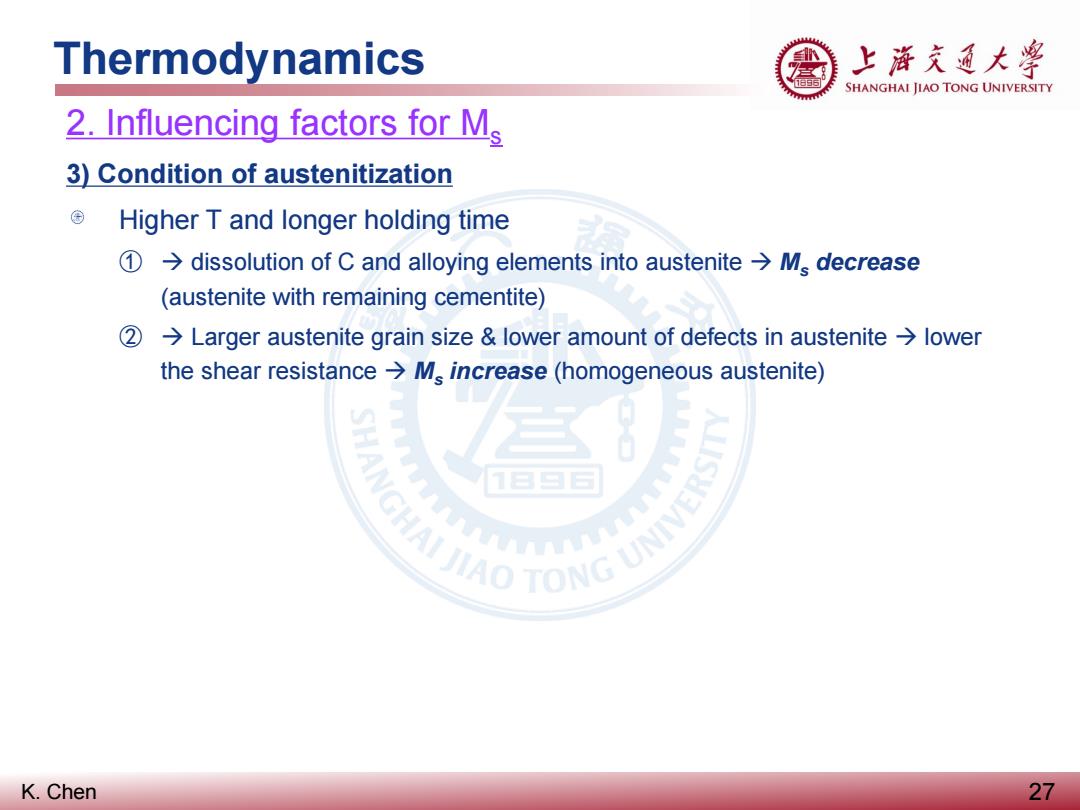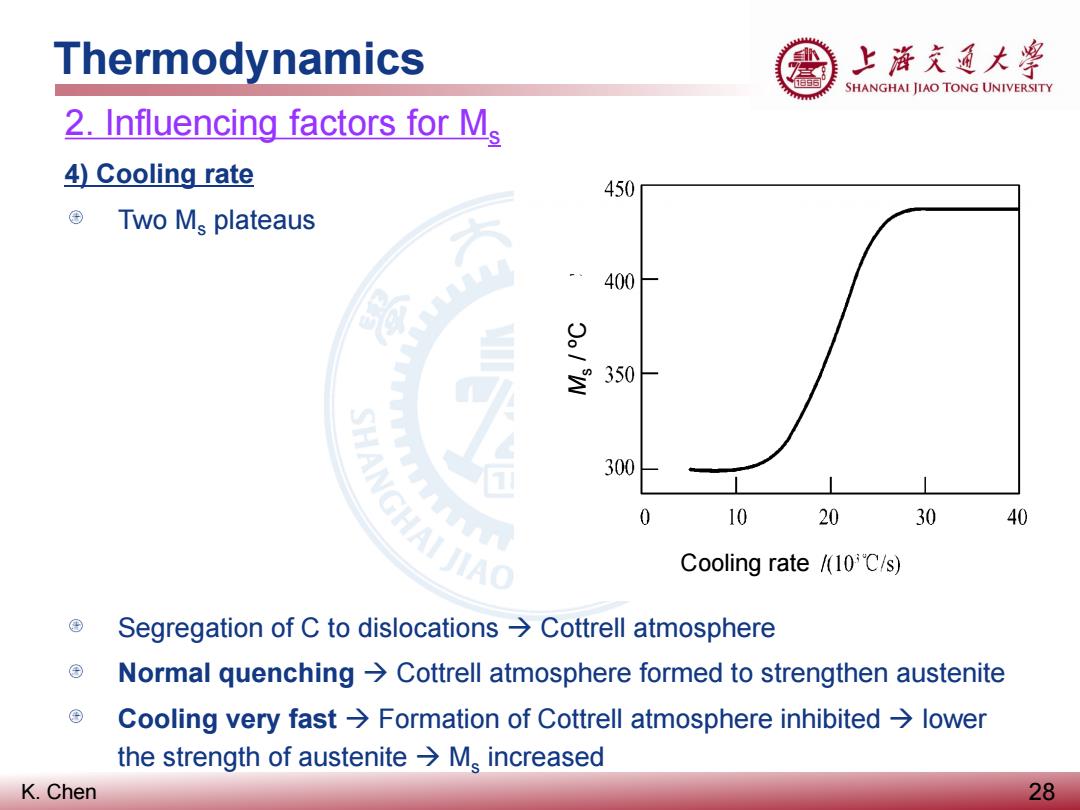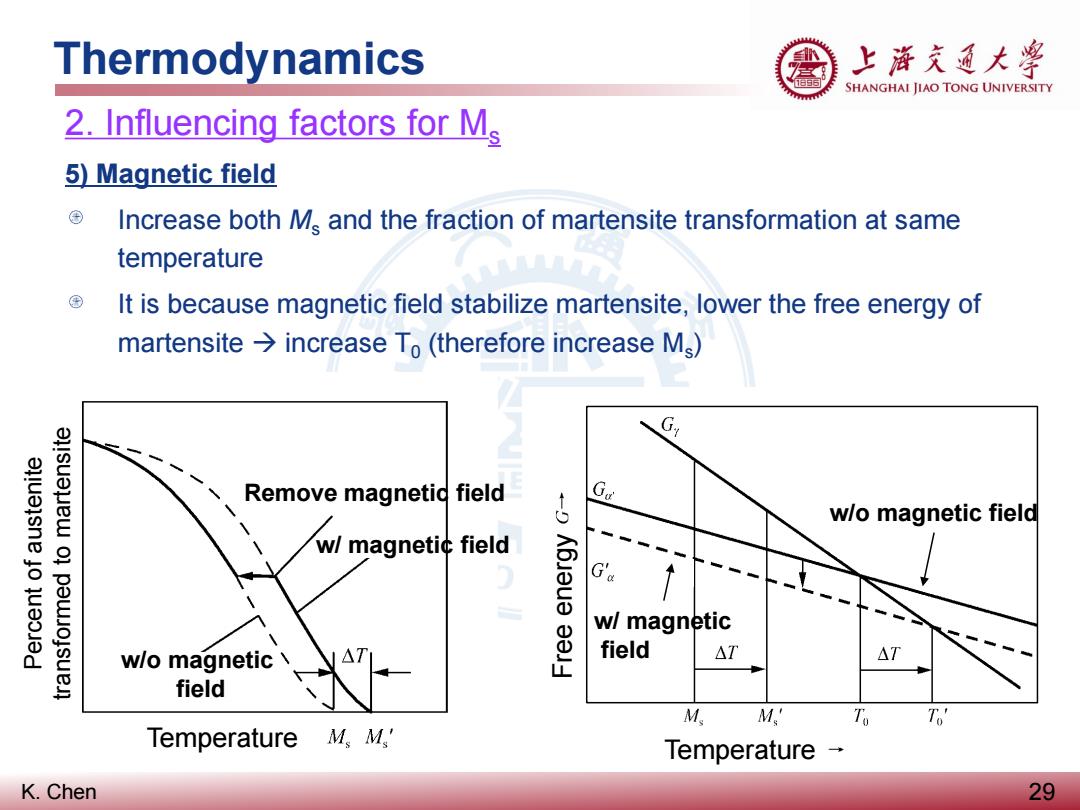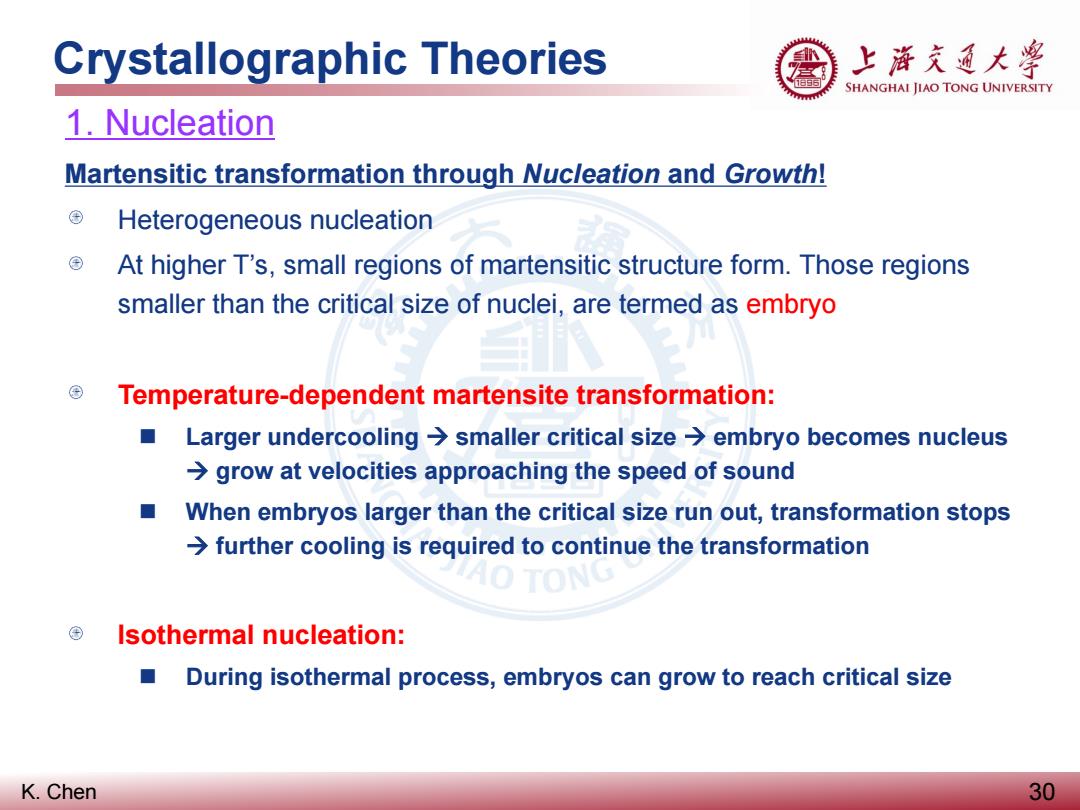
Thermodynamics 上游充通大学 SHANGHAI JIAO TONG UNIVERSITY 2.Influencing factors for Ms 2)Plastic deformation and stress Plastic deformation Not only the martensite transformation can be induced in M~M,but also the transformation fraction can be increased in M~M;by deformation. Larger deformation and/or deformation at lower T>more deformation induced martensite transformation Stress Uni-axial compression>M?N Tensile→Ms? Multi-axial compression>M.? K.Chen 26
K. Chen Thermodynamics 26 2. Influencing factors for Ms 2) Plastic deformation and stress Plastic deformation Not only the martensite transformation can be induced in Md~Ms, but also the transformation fraction can be increased in Ms~Mf by deformation. Larger deformation and/or deformation at lower T more deformation induced martensite transformation Stress Tensile Ms? Uni-axial compression Ms? Multi-axial compression Ms?

Thermodynamics 上游充道大粤 SHANGHAI JIAO TONG UNIVERSITY 2.Influencing factors for Ms 3)Condition of austenitization Higher T and longer holding time ①→dissolution of C and alloying elements into austenite→Ms decrease (austenite with remaining cementite) 2>Larger austenite grain size lower amount of defects in austenite lower the shear resistance >M increase (homogeneous austenite) NGHAI JIAO TONG UNIVEY K.Chen 27
K. Chen Thermodynamics 27 2. Influencing factors for Ms 3) Condition of austenitization Higher T and longer holding time ① dissolution of C and alloying elements into austenite Ms decrease (austenite with remaining cementite) ② Larger austenite grain size & lower amount of defects in austenite lower the shear resistance Ms increase (homogeneous austenite)

Thermodynamics 上浒充通大粤 SHANGHAI JIAO TONG UNIVERSITY 2.Influencing factors for Ms 4)Cooling rate 450 ©Two Ms plateaus 400 MMAM 350 SHANGHAIJIAC 300 0 10 20 30 40 Cooling rate/10℃/s) Segregation of C to dislocations>Cottrell atmosphere Normal quenching>Cottrell atmosphere formed to strengthen austenite Cooling very fast>Formation of Cottrell atmosphere inhibited>lower the strength of austenite>M.increased K.Chen 28
K. Chen Thermodynamics 28 2. Influencing factors for Ms 4) Cooling rate Two Ms plateaus Segregation of C to dislocations Cottrell atmosphere Normal quenching Cottrell atmosphere formed to strengthen austenite Cooling very fast Formation of Cottrell atmosphere inhibited lower the strength of austenite Ms increased Cooling rate Ms / ºC

Thermodynamics 上游充通大粤 SHANGHAI JIAO TONG UNIVERSITY 2.Influencing factors for Ms 5)Magnetic field Increase both Ms and the fraction of martensite transformation at same temperature ⊕ It is because magnetic field stabilize martensite,lower the free energy of martensite>increase To(therefore increase M) Remove magnetid field Gd w/o magnetic field w/magnetic field K6Jaue G'& w/magnetic w/o magnetic field △T △T field M M' T To' Temperature M.M.' Temperature K.Chen 29
K. Chen Thermodynamics 29 2. Influencing factors for Ms 5) Magnetic field Increase both Ms and the fraction of martensite transformation at same temperature It is because magnetic field stabilize martensite, lower the free energy of martensite increase T0 (therefore increase Ms) w/ magnetic field w/o magnetic field Percent of austenite transformed to martensite Temperature Remove magnetic field w/ magnetic field w/o magnetic field Temperature Free energy

Crystallographic Theories 上游充道大粤 SHANGHAI JIAO TONG UNIVERSITY 1.Nucleation Martensitic transformation through Nuc/eation and Growth! Heterogeneous nucleation At higher T's,small regions of martensitic structure form.Those regions smaller than the critical size of nuclei,are termed as embryo Temperature-dependent martensite transformation: Larger undercooling smaller critical size>embryo becomes nucleus grow at velocities approaching the speed of sound When embryos larger than the critical size run out,transformation stops further cooling is required to continue the transformation Isothermal nucleation: During isothermal process,embryos can grow to reach critical size K.Chen 30
K. Chen Crystallographic Theories 30 1. Nucleation Martensitic transformation through Nucleation and Growth! Heterogeneous nucleation At higher T’s, small regions of martensitic structure form. Those regions smaller than the critical size of nuclei, are termed as embryo Temperature-dependent martensite transformation: Larger undercooling smaller critical size embryo becomes nucleus grow at velocities approaching the speed of sound When embryos larger than the critical size run out, transformation stops further cooling is required to continue the transformation Isothermal nucleation: During isothermal process, embryos can grow to reach critical size